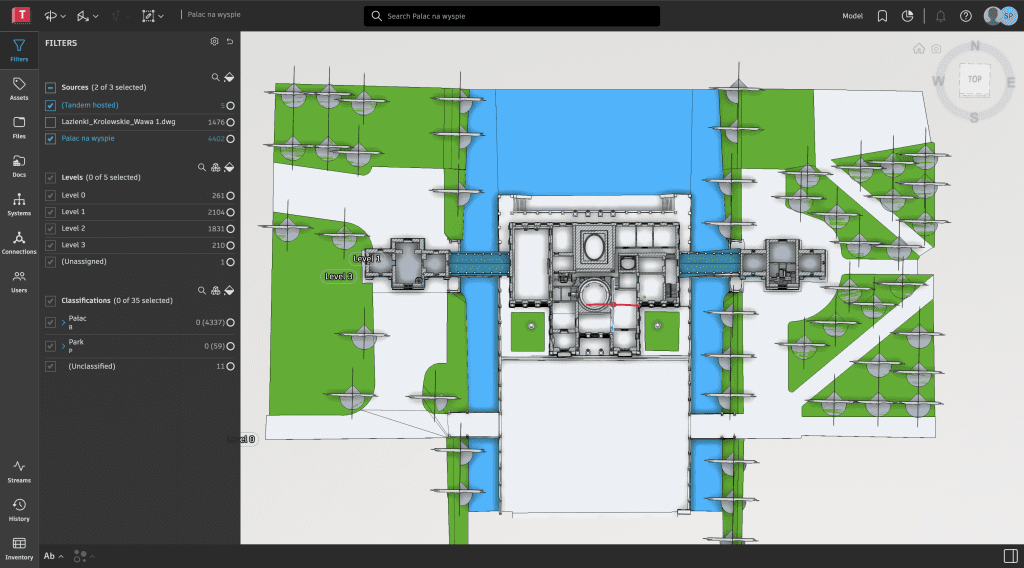How Dawood is using Autodesk Tandem for digital twin innovation
In the heart of Warsaw lies the Royal Łazienki Museum – an 18th-century palace and garden complex that has witnessed centuries of Polish history. Today, thanks to Dawood’s cutting-edge application of digital twin technology and Autodesk Tandem, this historic site is not only being preserved but brought into the digital age. Now operating as a Woolpert Company, Dawood continues to lead the way in innovation across the built environment.
At Autodesk, we know that the digital handover of building data can make or break long-term asset value. That’s why we’re excited to highlight how Dawood is utilising Autodesk Tandem to bridge the gap between design, construction and operations – especially through its Twin Track process.

Bridging the physical and digital
Dawood, a firm deeply committed to innovation and sustainability, was tasked with creating a comprehensive digital twin of the Royal Łazienki Museum. This wasn’t just about 3D modelling – it was about capturing and contextualising operational data in a way that could support the museum’s long-term conservation, facility management and visitor experience.
Using Tandem, Dawood brought together multiple data sources – including laser scans, photogrammetry and Revit models – into a single united digital environment. This resulted in a centralised, connected model that tells the story of the building both historically and functionally.
The Twin Track methodology
At the core of Dawood’s strategy is Twin Track – a unique framework that uses digital twins not just as static models but as living tools for monitoring performance, planning interventions and even engaging stakeholders.
Autodesk Tandem plays a pivotal role here. By enabling structured data capture from the start of the project lifecycle, Tandem allows Dawood to define, track and deliver the exact information needed at each phase. Asset metadata, system interconnectivity and real-time sensor inputs all find a home in the twin, creating a powerful platform for analysis and action.
Whether it’s scheduling maintenance on historic HVAC systems or planning conservation efforts without disrupting visitor traffic, Dawood’s team can now visualise and simulate different scenarios before they happen.

“Commonly used for buildings, Twin Track is now streamlining on-site tasks ranging from specific tree inventory to location coordinates. Property staff use the native app to prioritise the preservation of ageing trees and maintain a bi-annual trimming cycle.”
Seeing the long-term value
For the Royal Łazienki Museum, the benefit is clear: a proactive, intelligent approach to building stewardship. For Dawood, it’s about delivering higher value to clients through better data, better coordination and better outcomes including:
- 90% reduction in inspection time through mobile app automation, eliminating paper-based processes and enabling instant notifications and reporting.
- 30% fewer site visits thanks to intelligent scheduling and remote monitoring capabilities.
- 45–60 minutes saved per data access session with immediate availability of building information and rapid measurements via the digital twin.
- 23% reduction in rework costs by maintaining comprehensive work history and inspection records, improving contractor accountability and quality control.
For Autodesk, it’s a glimpse into the future we’re helping build – where digital twins aren’t just buzzwords but everyday tools that allow teams to work efficiently, preserve more and plan confidently. Whether you’re maintaining a centuries-old palace or managing a modern commercial space, Autodesk Tandem is here to help you make every decision count.
Want to see how Tandem can transform your operations? Explore Dawood’s digital twin services, their Royal Łazienki case study and discover what our digital twin readiness assessment could mean for you.
More resources
Discover more articles, webinars, and whitepapers. Here are a few we think could be of interest.